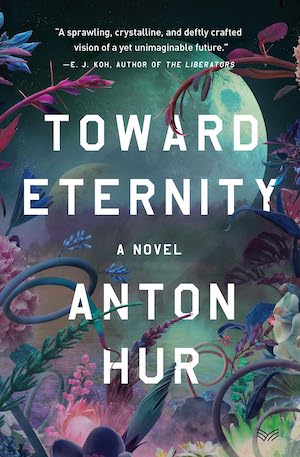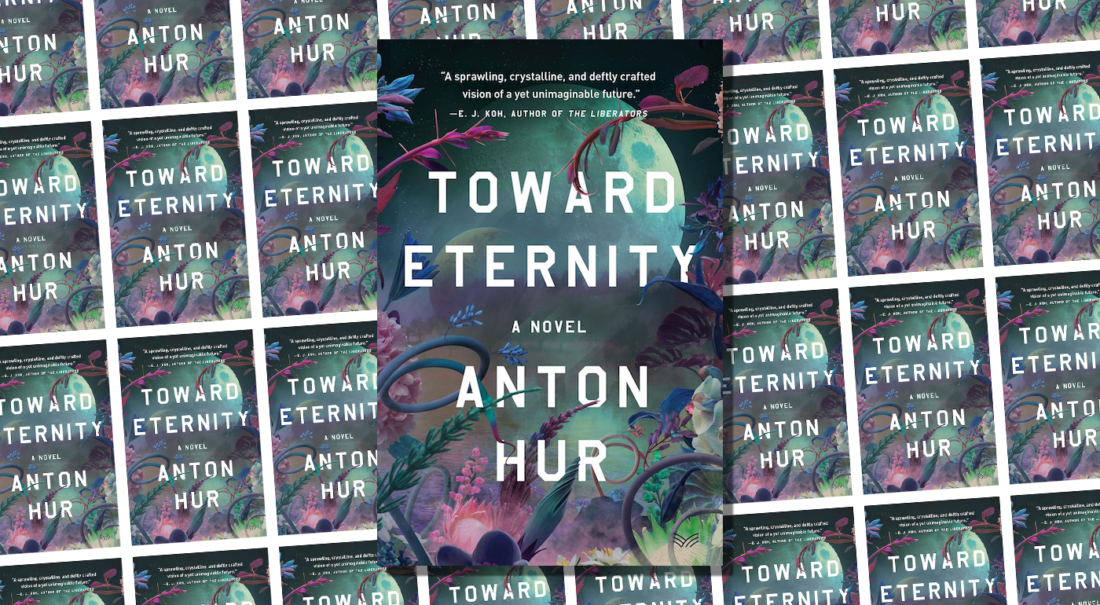Speculative fiction is no stranger to existential inquiry. I most often observe such themes emerging organically, a philosophical haze rising from an invented landscape. Yet then there are also books like Kazuo Ishiguro’s Klara and the Sun, or to give an older and stranger example, Arthur C. Clarke’s Childhood’s End. I would argue that those novels are constructed around a core of questions, establishing their explorations of humanity and technology as narrative backbones. Celebrated translator Anton Hur’s Toward Eternity joins this company, offering its readers a centuries-spanning world and a series of narrators bound together by expansive meditations on selfhood, art, and language.
What is the relationship between body and soul? Are our personalities simply amalgamations of our memories, or is there another indefinable piece that makes us? Is love a strong enough force that it can exert itself separately from the lover and beloved? Where does art originate—inside a human consciousness, or in the fabric of the universe itself? How does experiencing art shape one’s self? Is language central to the formation of self-awareness and individuality?
These are only some of the questions Hur poses in his debut novel. It would be impossible to list all of them, which reflects the fact that Toward Eternity also defies easy summary. The tale is told by many voices, the conceit being that the book is the handwritten contents of a notebook begun by Dr. Mali Beeko, and continued by each narrator in succession. In a society where a person can “transition” out of their failing human body to one made entirely of nanites, the physical nature of Hur’s framing device becomes an anchor for the characters as well as a thematic vessel for questions around authenticity, historical record, and language preservation.
Buy the Book

Toward Eternity
While Hur delves into much more distant possibilities as his story progresses, the first third of his novel takes place in an almost recognizable era; indeed, the section is titled “Part 1: The Near Future.” Bringing to mind recent news regarding the successful implantation of Neuralink’s computer-brain interfaces, our first round of characters are involved in the groundbreaking discovery of nanite therapy and its ensuing clinical trials. The aforementioned Dr. Mali Beeko is the child of Dr. Nomfundo Beeko, who invented a way of giving terminally ill patients nanodroid bodies, rendering them not only healthy but immortal. Toward Eternity’s inciting incident is the disappearance of Patient One, Yonghun Han, the first person to successfully receive such nanite therapy. The police and Mali are baffled, but then Yonghun inexplicably returns. He steals the notebook Mali began writing in to process Patient One’s potential ‘rapture’, and records that he does not believe he is the real Yonghun Han. Despite having all of Yonghun’s “memories, his personality, his habits, and everything that one might construe as ‘him’”, the writer feels he is only a channel for language and emotion emanating from the love Yonghun and his husband Prasert felt for each other.
After this version of Yonghun has recorded what he finds necessary, he passes the notebook to Patient Two, a famed cellist named Ellen who begins to see copies of herself everywhere. The next archivist is Panit, an AI who was part of Yonghun’s research, and grew into sentience from consuming and analyzing poetry. Panit is also given a nanodroid body, and his lonely but embodied immortality takes us into “Part 2: The Future.” In both this section and the next, a mega-corporation named JANUS threatens humanity as we know it. JANUS, you see, is run by AI—for efficiency’s sake.
As an all-powerful evil AI suggests, Toward Eternity employs many standard elements of the genre in its second half. Hur is exploring why we return again and again to ideas of AI warfare, clones, a last bastion of humanity, an uninhabitable earth. Though of course the novel offers no answer, it does underscore the way art echoes throughout centuries, gaining a life of its own as it is re-read, re-spoken, re-heard. As (the real) Yonghun claims early on: “Poets are artists who write selves into being. […] When one reads the poem, one becomes that self.”
I could keep listing characters and events, but that wouldn’t capture the true texture of a novel that feels like a large-scale reflection more than anything else. As a later character asserts, “languages contain more than primary meaning.” Hur’s writing is rife with metaphor and implication, so his creations become inert when stripped from their context. The philosophical undergirding of Toward Eternity is what animates it, and readers looking for such a heady experience will find plenty to delve into within its pages.
Toward Eternity is published by HarperVia.
